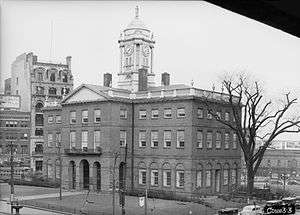Alse Young
Alse Young (ca. 1600 – 26 May 1647) of Windsor, Connecticut — sometimes Achsah Young or Alice Young — was the first recorded instance of execution for witchcraft in the thirteen American colonies.

Background and execution
Very little is recorded of Young; her existence is only known through her reputation as a witch. She is believed to have been the wife of John Young, who bought a small parcel of land in Windsor in 1641, sold it in 1649, and then disappeared from the town records. She had a daughter, Alice Young Beamon, who was accused of witchcraft in nearby Springfield, Massachusetts, some 30 years later. Even though Alice Young was a woman without a son when the witchcraft accusation was lodged, her husband was still alive during her accusation. This makes it unlikely that she was accused simply for the possibility of inheriting her husband's estate in the future. Other reasons are more probable.
There is no record of Young's trial or the specifics of the charge. Historical records indicate that an influenza epidemic took hold in New England, including Windsor, in early 1647. Mortality increased dramatically that year and included many children. It is possible that Young was blamed for these deaths. She may have been hanged at the Meeting House Square in Hartford, Connecticut, now the site of the Old State House, since a jail was on the edge of the square. A journal of then Massachusetts Bay Colony Governor John Winthrop mentions "One... of Windsor arraigned and executed at Hartford for a witch." [1] The second town clerk of Windsor, Matthew Grant, confirms her execution with the May 26, 1647, diary entry, "Alse Young was hanged."
Exoneration
At the urging of Beth Caruso, a local historian who wrote a book on her case, Alyse Young was formally exonerated on February 6, 2017 by a unanimous vote of the Windsor Town Council, along with Lydia Gilbert, the second Connecticut woman to be executed for witchcraft, who was also from Windsor.[2]
See also
References
- John Winthrop, Journal: 1630-49, ed. James K. Hosmer (New York, 1908), II, 323.
- Jennifer Coe, "Windsor Passes Witch Execution Resolution", Hartford Courant, March 17, 2017.
Further reading
- David D. Hall, (editor), Witch-Hunting in Seventeenth Century New England, Boston: Northeastern University Press, 1999, ISBN 1-55553-416-3
- John Demos, Entertaining Satan: witchcraft and the culture of early New England, Oxford University Press, 1982, pp. 346–347.
- John M. Taylor, The Witchcraft Delusion In Colonial Connecticut (1647-1697), online at Project Gutenberg.
- Annie Eliot Trumbull, "One Blank of Windsor", Literary Section, Hartford Courant, December 3, 1904.
- Beth M Caruso, One of Windsor: The Untold Story of America's First Witch Hanging, Hartford: Lady Slipper Press, 2015, ISBN 0692567038
- Windsor Community Television, Alse Young's Final Journey, December 1, 2016.
External links
- Alse Young profile, damnedct.com; accessed December 26, 2014.
- Witches and Witchcraft at the Connecticut Judicial Branch Library, jud.ct.gov; accessed December 26, 2014.
- Alse Young - The Grimm Generation, Soundcloud, accessed February 27, 2017